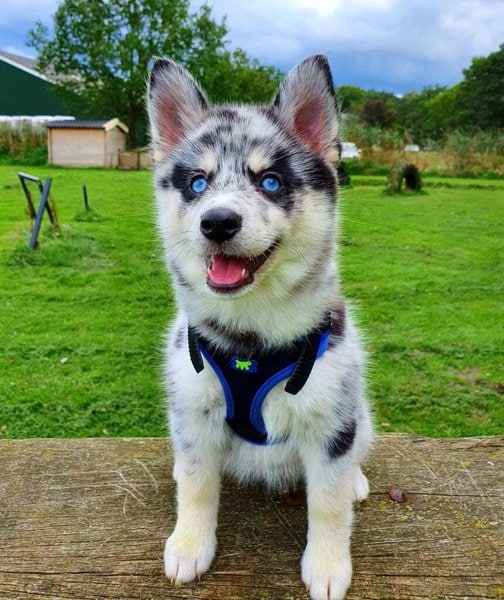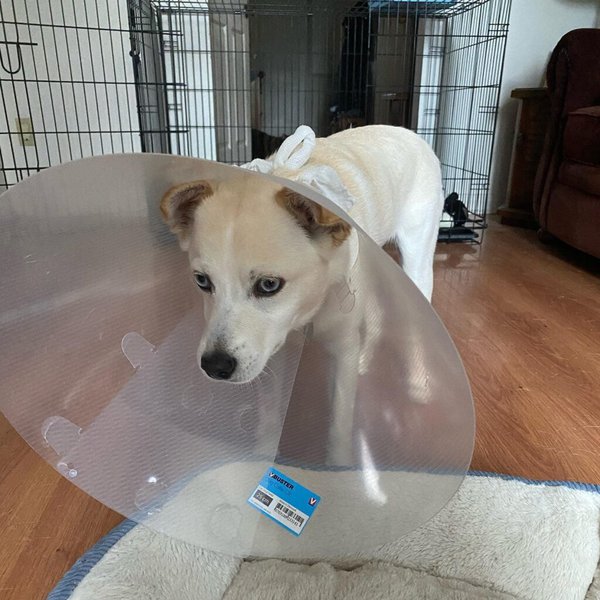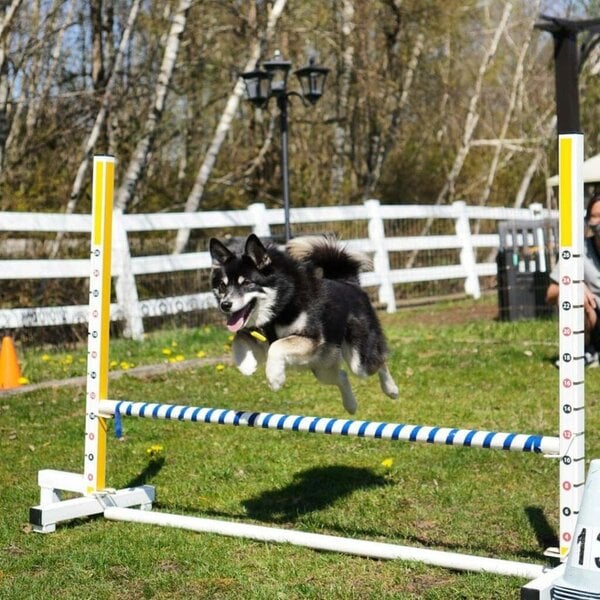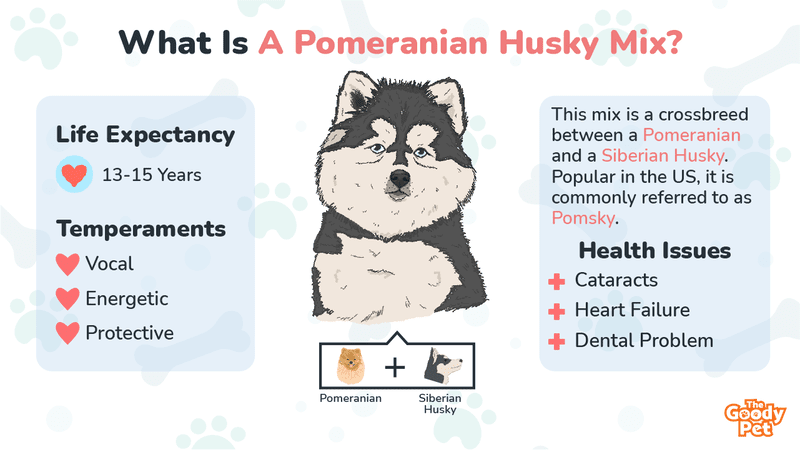Due to their increasing popularity, designer dogs are at the center of public attention on social media platforms in the United States. Many people, especially celebrities, will never pass up an opportunity to post photos of their cute designer dogs on various social platforms. One such dog is the Pomeranian Husky Mix which this article is going to look at.
Pomeranian Husky Mix is a breed that comes from a crossbreed between a Pomeranian and a Siberian Husky. In the eyes of Pomeranians’ and Huskies’ lovers, Pomeranian Husky Mix is commonly referred to as Pomsky.
In this article, I will share the important information you will need to know about the Pomenarian Husky breed before you decide on getting a Pomsky as a pet. Understanding the lifespan and health issues of Pomsky, taking the right steps in caring for a Pomsky, learning its temperaments, as well as grooming tips for a Pomsky. Let’s get started!
How Big Is A Full Grown Pomsky?
Pomsky is a breed between a small Pomeranian and a Siberian Husky that is typically twice larger than a full-grown Pomeranian.
Before you bring home a Pomsky, you will want to know how big it can grow so that you can make the necessary preparations, like finding out the right measurements for a dog bed or a housing crate.
Size
The size of Pomsky will largely depend on which parental breed the Pomsky takes after. If a Pomsky comes from a Miniature Siberian Husky and a male Pomeranian, you can certainly expect the size of your Pomsky to be smaller than average.
If your Pomsky takes after the Husky’s gene, they will be bigger, but if they take more Pomeranian, it will result in a smaller pooch.
Typically, you can expect the size of a full-grown Pomsky to weigh between 20 to 30 lbs, a height of 10 to 15 inches tall from paws to shoulders, and a body length of 12 to 17 inches long from chest to the rear.
Appearance
Most Pomskies take after the features of Huskies in terms of the shape of their heads and ears. Their ears are primarily triangular and erect. Your puppy’s eyes can be blue like that of a Husky or brown like a Pomeranian.
Also, you will expect your canine buddy to have a curved tail, round head, and body with a short muzzle and eyes close like that of a Pomeranian. From these characteristics, I can say that Pomsky looks cute, like a Siberian Husky dog with a small Pomeranian size.
Coat
A Pomsky has a thick fluffy double coat that comes in a wide range of colors. You will expect your pup to be white, red, spotted, brown, merle, black, cream, orange, brindle, or a combination of the aforementioned colors.

What Is The Lifespan Of A Pomsky?
With proper care, the Pomeranian Husky breed will have a lifespan of between 13 to 15 years.
If you are planning to adopt a Pomsky, it becomes your responsibility in providing the right care for your pooch. Hence, it is important to understand the health problems common with the Pomsky breed, especially problems coming from both parents, as these problems may manifest early in your puppy. Common health problems will include:
Hip Dysplasia And Dislocated Patella
You will soon find out that your maturing Pomsky may have either hip dysplasia or dislocated patella, if your doggy walks using one leg, limps for no particular reason, and wails in pain while walking or running.
In case you see any of these signs, it is advisable to take your puppy to the veterinarian for an examination. Though these conditions tend to be severe, it is still manageable with proper care and medication.
Dental Problems
Dental problems arise in a Pomsky as a result of the buildup of plaque in the mouth. Such problems are very common among many dog breeds, especially Pomeranians, and when proper dental hygiene is not observed.
The best way to avoid bacteria building in your pooch’s mouth is by brushing your Pomsky’s teeth once a day or to invest in dental water additives that can be added to your puppy’s drinking water. Also, don’t forget to visit your vet for regular dental checkups of your four-legged buddy.
Other Health Concerns
Other health conditions affecting your furry companion’s health can include cataracts and retinal problems, dermatitis, ear infections, and heart failure.
Another concern to note among Pomskies is tracheal collapse. Although it is a condition affecting primarily the Pomeranian breed, Pomskies are not spared from it either, due to having genes from the Pomeranian.
Collapsed trachea disease is characterized by coughing, shortness of breath, and intolerance to exercising. Anytime you notice these signs, take your pet to the vet as soon as possible for treatment.

How To Take Care Of Pomskies?
There are numerous ways to take proper care of your Pomsky. Here are the common ones.
Exercise
Pomskies are exceptionally playful, and they naturally enjoy exercises. Despite their playful nature, they also require structured daily activities to maintain their health and physical fitness. It is highly encouraged to offer your Pomsky daily routine exercises for about 45 minutes or even an hour long.
Pomskeys love indoor as well as outdoor activities so, you should consider taking your cute buddy for walks in the park, meeting with other dogs for play dates, and playing a game of fetch in the backyard.
These exercises not only maintain your dog’s health but also facilitate the building of a stronger bond with your Pomsky.
Diet
Pomskies are hyperactive and playful dogs, thereby requiring significant energy intake to keep going. You should provide your canine friend with high-quality food containing plenty of animal proteins, fats, and low carbohydrates.
The amount of food and calorie daily intake for your Pomsky is largely dependent on its size. We have included a feeding guide here for your reference:
- 5 to 8 lbs – ½ to ¾ cup per day
- 8 to 10 lbs – ½ to ¾ cup per day
- 10 to 12 lbs – ¾ to 1 cup per day
- 13 to 17 lbs – 1 to 1¼ cups per day
- 20 lbs and above – 2 cups per day
Alternatively, we recommend Pet Plate. It comes with freshly prepared meals and servings apportioned for your Pomsky. In this way, you can free up more time instead of spending it on food preparation.
In addition, vitamin supplements are essential to keep your dog healthy and more robust, so you should consider adding and mixing them into the meals for your pooch.
Dental Additives
Dental health is also an important area not to be ignored when your Pomsky’s health is concerned. A number of ways to keep your puppy’s teeth healthy include daily brushing, regular dental checkups, and investing in dental water additives.
We recommend using dental water additives due to the convenience and simplicity that these additives bring. Simply add one teaspoon to your Pomsky’s daily serving of drinking water and you are all set!
Why Does My Pomsky Howl? Temperaments Of Pomeranian Husky Mixes
The Pomeranian and Siberian Husky dog breeds share some personality traits that will often show up in the Pomsky offspring. Let us take a closer look at these traits.
Vocal
As all other Huskies do, Pomskies can be quite vocal and do so with either barking or howling. Besides displaying some form of a barking tendency, they often howl if they are bored or they are simply trying to communicate with other Pomskies or Huskies within the vicinity. You will also find that your canine buddy howls at sirens, music, or during nighttime.
Intelligence
Coming from a Siberian Husky’s working dog background coupled with a Pomeranian’s slightly high intelligence level, a Pomsky is a brilliant and smart dog making it easy to train.
However, there are times when Pomskies may inherit the obstinacy of Pomeranian parents, and they will need to be dealt with through calm, assertive leadership and patience. It is always good to start socialization training with your Pomsky puppy in the early stages to curb the stubbornness trait.
Protective
It is in Pomskies’ nature to be faithful and protect their loved owners from harm. To do that, they tend to bark at things or strangers to alert owners. This makes them good watchdogs.
However, it is this same tendency that leads to another problem – incessant barking. This comes whenever the Pomsky is feeling anxious or insecure, if left alone for long hours or frightened by thunderstorms, seeking the attention of owners, barking for food, or when feeling unwell.
On the other hand, If your pup rarely barks but suddenly becomes more vocal, it’s good to check up on your pooch to find out the problem. Your pooch can probably be warning you about something.
Energetic
Pomsky is a dog breed of high energy levels. As such, without sufficient mental stimulation, your furry friend may exhibit small dogs syndrome, thereby becoming more aggressive and destructive.
This behavior includes jumping on people and other dogs, snapping at threats, the fear of larger dogs, growling, biting, or displaying the reluctance to obey simple commands like moving off couches or beds.
However, you can curb this syndrome with proper training, socialization, and regular exercises to allow your Pomsky to burn off excess or pent-up energy that makes it destructive.

Are Pomskies Hypoallergenic? Grooming Tips For Pomeranian Husky Mixes
Pomskies unfortunately shed on moderately high levels, twice a year, and may trigger allergies. For dog lovers who are easily affected by allergic triggers, do stay away from Pomskies and their dander. In other words, Pomskies are not hypoallergenic.
Despite being not hypoallergenic, Pomskies are double-coated dogs, so grooming your doggy hair on a regular basis is recommended.
Grooming
As part of grooming, brushing your Pomsky daily is beneficial in many ways. Not only does frequent brushing stimulate blood flow, but it also helps to remove tangles and fleas and prevent matting.
For brushing, we highly recommend the FURminator Undercoat Tool. Its ergonomically designed handle provides a firmer grip for you to groom your Pomsky with much ease and speed, such that you need not be exposed to its loose fur no longer than you need to be.
Another part of grooming involves trimming your Pomsky’s nails every week, keeping them short should provide more comfort for your puppy.
Bathing
It is highly recommended that you bathe your Pomsky every two months, and you should bathe them every month during summer and once every bimonthly during winter. If your furry friend spends most of its time outdoors, you should bathe them once a month due to the dirt and mud they are frequently exposed to.
When bathing your doggy, we recommend Mighty Petz 2-In-1 Oatmeal Dog Shampoo And Conditioner. Not only does it help in maintaining your puppy’s coat and retaining the natural oils, but this shampoo also moisturizes the coat, giving it a shiny and firmer look.
Related Questions
How Much Does A Pomeranian Husky Mix Cost? If you want to purchase a healthy Pomsky, be ready to spend between $2,000 and $4,000. One reason why Pomskies fetch such a high price is due to the breeding process, which involves artificial insemination and is typically costly. Other factors influencing pricing can be the location where the purchase is to be made, the reputation of the breeders, and the origins of the parent breeds.
Do Pomskies Like Water? Yes, Pomskies do love the water. They sure do love wading in shallow water, and will not mind swimming. Hence, many Pomsky owners occasionally take their pups to the beach or the swimming pool for a swim. It will be best if you also take your Pomsky puppy to the swim once in a while, but always under supervision to avoid an unfortunate drowning incident.
Can I Breed A Pomeranian With A Pomsky? Yes, you can do so by breeding a Pomeranian with a Pomsky, typically an F1, to obtain an F1b offspring which will either be 75% Husky and 25% Pomeranian, or 75% Pomenarian and 25% Husky. However, the breeding process cannot be done naturally because Huskies don’t get along with smaller dogs, meaning that a Husky male cannot safely mate with a Pomeranian female. The only way to breed the two is through artificial insemination.





